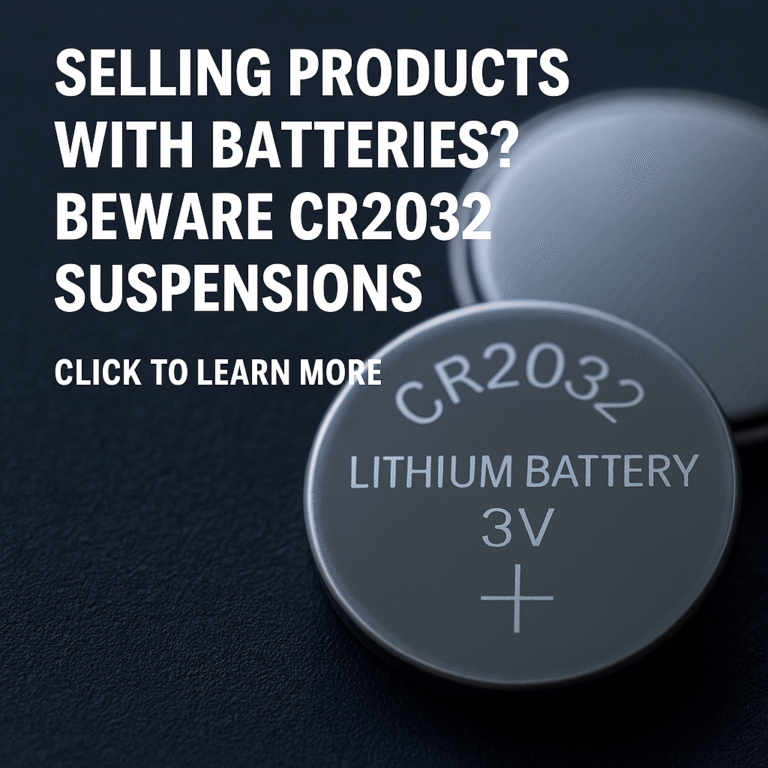CR2032 Batteries Are Killing Amazon Listings - Here’s Why Yours Might Be Next
CR2032 Batteries Are Killing Amazon Listings - Here’s Why Yours Might Be Next

You’ve listed a small electronic device on Amazon. It’s tested, functional, and compliant (or so you think). You’ve been selling it steadily for months.
Then – without warning – Amazon takes the listing down.
This product causes a safety risk. We will not be reviewing any documents for this ASIN.”
The email offers no path for appeal. Your inventory becomes stranded. Your compliance folder sits untouched. You’re locked out with no explanation, and no amount of support tickets will get it reopened.
This is the new reality for any Amazon seller whose product includes a CR2032 coin cell battery – and who isn’t prepared for the complex web of safety regulations Amazon now enforces.
What Is a CR2032 - and Why Amazon Cares So Much
A CR2032 is a 3-volt lithium manganese dioxide coin cell battery. It’s roughly the size of a nickel: 20mm in diameter and 3.2mm thick. You’ll find it in thousands of common consumer devices – key fobs, pet trackers, glucose meters, kitchen thermometers, laser pointers, scales, and wearable tech.
It’s small, cheap, reliable – and also dangerous. Not because of what it does, but because of what can happen if a child swallows one.
When swallowed, a CR2032 can become lodged in the esophagus and cause internal tissue burns, bleeding, or death in under 2 hours. This risk isn’t hypothetical. It has been documented repeatedly by emergency medicine departments around the world.
That’s why the U.S. Congress passed Reese’s Law in 2022, which required the Consumer Product Safety Commission (CPSC) to adopt stricter regulations for products containing button or coin cell batteries.
As of March 2024, those rules – codified under 16 CFR Part 1263 – are in full effect. Amazon is now enforcing them at scale. If your product listing has been flagged or removed due to these regulations, you may need to file an Amazon product safety complaint appeal to have your listing reinstated. Understanding how to navigate the product safety issue Amazon appeal process is crucial for sellers whose products contain CR2032 batteries or similar components, as compliance with these safety standards is now mandatory for marketplace participation.
The Core of Compliance: UL 4200A and 16 CFR 1263
To comply with Reese’s Law, products containing coin batteries must meet the design and labeling requirements set forth in ANSI/UL 4200A. This standard includes:
🔒 Battery Compartment Security
The battery must be inaccessible to a child during normal or foreseeable use.
Battery enclosures must either:
Require a tool (e.g., screwdriver) to open, or
Require two independent, simultaneous actions (e.g., push and slide).
🛠 Abuse Testing
UL 4200A includes a set of rigorous physical tests to simulate child misuse:
Drop test: The product must withstand multiple 1-meter drops without the battery becoming accessible.
Crush test: A 330N (74 lbf) force is applied to ensure the battery doesn’t pop loose.
Impact test: A steel ball is dropped to simulate blunt force.
Torque & tension tests: Applied to potential pry points.
Probe test: A 50N force with a standardized test probe must not access the battery.
These tests are not theoretical. If your battery door fails just one of them, your product is considered non-compliant.
⚠️ Warning Label Requirements
The packaging must include:
The word “WARNING” in bold, capital letters
A safety icon (exclamation triangle)
A message like:
“Keep out of reach of children. Swallowing may cause serious injury or death. Seek medical attention immediately.”
Text must be a minimum of 5mm high for the signal word and 2.5mm for body text
Placement must be on the principal display panel, not hidden in small print
The labeling requirement is mandatory for products manufactured after September 21, 2024, but many sellers are being flagged earlier.
The Compliance Chain: Where Sellers Fail
Amazon’s ingestion hazard enforcement is largely automated, and it doesn’t take a visible complaint to trigger a takedown. In fact, most CR2032-related listing removals result from metadata mismatches, undeclared components, or insufficient documentation.
Here are the most common causes of listing shutdowns:
1. Missing Backend Declaration
If a product contains a CR2032 but the seller fails to declare it in Seller Central – especially in the compliance fields – Amazon interprets that as concealment. The moment their system detects or suspects the battery (via listing content, keywords, category audit, or customer image), the ASIN is suspended and marked ineligible for documentation review.
2. Incorrect Battery Type
Many sellers mistakenly list the battery type as CR2 (a cylindrical battery) instead of CR2032 (a coin cell). This isn’t a small mistake. Amazon treats it as an integrity issue. If your packaging says CR2032 and your backend says CR2, you’ve created a data mismatch that triggers ingestion hazard review.
3. No UL 4200A Documentation Submitted
UL 4200A is now the accepted baseline for coin battery safety. Amazon expects a full test report from an ISO 17025 lab. If that report is missing, outdated, or too vague (e.g., doesn’t specify the product SKU), the listing may be suspended, even without a customer complaint.
4. Lack of a GCC (General Certificate of Conformity)
Per 16 CFR Part 1263, all general-use consumer products containing a CR2032 must be accompanied by a signed GCC referencing UL 4200A. Amazon compliance teams frequently reject appeals that lack this one-page certificate – even if the lab report is included.
5. No Warning Label on Packaging
If your packaging doesn’t visibly show the required ingestion hazard warning, Amazon may reject your documentation outright – even if your product passes all tests. Visual evidence is often required.
6. Loose Spare Battery
If your product ships with an extra CR2032 and it’s not in child-resistant packaging, your listing is non-compliant. Spare batteries must be sealed in blister packaging or a safety-tested single-release pack. Loose coin cells are a regulatory red flag.
What Amazon Expects - Even if They Don’t Tell You
Amazon rarely gives sellers step-by-step guidance on compliance. But after analyzing dozens of ingestion hazard removals and reversals, we’ve identified the standard Amazon silently enforces.
✅ What to Declare in Seller Central
-
Battery Type: CR2032
-
Battery Chemistry: Lithium metal
-
Battery Count: (e.g., 1 or 2)
-
Battery Weight: ~3g per battery
-
Battery Placement: Contained in equipment
✅ What to Upload to Compliance Portal
-
UL 4200A test report (must reference product ID and battery type)
-
Signed GCC listing:
-
Manufacturer/importer
-
Product name + ASIN
-
Test standard (UL 4200A / 16 CFR Part 1263)
-
Lab name + date
-
Signature + date
-
-
Photo of packaging showing warning label
-
Battery SDS (optional, but useful for hazmat clearance)
If You’re Already Flagged
If Amazon has already removed your listing with a message like:
“This product causes a safety risk. We will not be reviewing any documents.”
You’re in Tier 1 ingestion hazard lockout – which means Amazon won’t even open your attachments unless:
-
You correct the backend battery declaration
-
You resubmit a complete, aligned package
-
You frame your appeal as a corrected procedural oversight, not a product defense
Example appeal positioning:
“After reviewing our internal product registration, we discovered the battery was previously misclassified in Seller Central. The product does include a CR2032, and we’ve now corrected this. Attached are our UL 4200A test results, our General Certificate of Conformity, and a product image showing proper battery warnings and security features. We respectfully request reconsideration based on this correction and our compliance with all relevant safety requirements.”
If your backend says CR2, but the label says CR2032 – you’re blocked. If your backend says nothing about batteries, but your packaging clearly contains one – you’re blocked.
Fix the backend first. Then appeal.
Final Thought: The Coin Battery Isn’t the Threat - Misinformation Is
Amazon’s compliance teams don’t remove listings because CR2032 batteries are dangerous in themselves. They remove listings because sellers fail to declare, document, and label them correctly.
Ingestible risk ≠ product flaw. It’s a design and communication issue.
So if your product includes a CR2032:
-
Don’t hide it
-
Don’t mislabel it
-
Don’t skip the warning
-
Don’t assume that “working fine” means “compliant”
Because when the ingestion risk is real, silence gets punished harder than error.
If you’re unsure whether your product is compliant, need help correcting backend records, or want us to review your UL 4200A report and GCC – reach out.
We’ve helped hundreds of sellers prevent or reverse ingestion hazard takedowns. We know what Amazon wants – even when they don’t say it.
And we can help you stay compliant, visible, and fully protected.
Inspired by real enforcement trends, regulatory mandates, and Amazon ingestion hazard policy reviews. All product references and examples are illustrative only.
Final Word: Why Compliance is a Mindset, Not Just a Folder
Amazon isn’t out to punish good sellers, but their process is ruthless. In this space, operational maturity is your best defense. Sellers who treat every complaint like an audit, and who build a culture of documentation and escalation, are the ones who get their listings back online fast – and sleep at night.
If you need a second set of eyes on your food safety documentation, or a hand building a truly Amazon-proof compliance process, reach out.
This is what we do – so you can keep selling, keep growing, and never lose a day to paperwork panic again.
Inspired by real Amazon investigations and appeals managed by ASA Compliance Group. All identifying details have been anonymized or changed for privacy.
